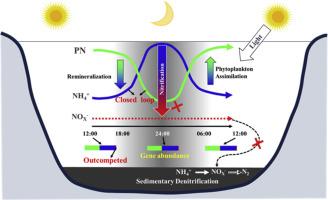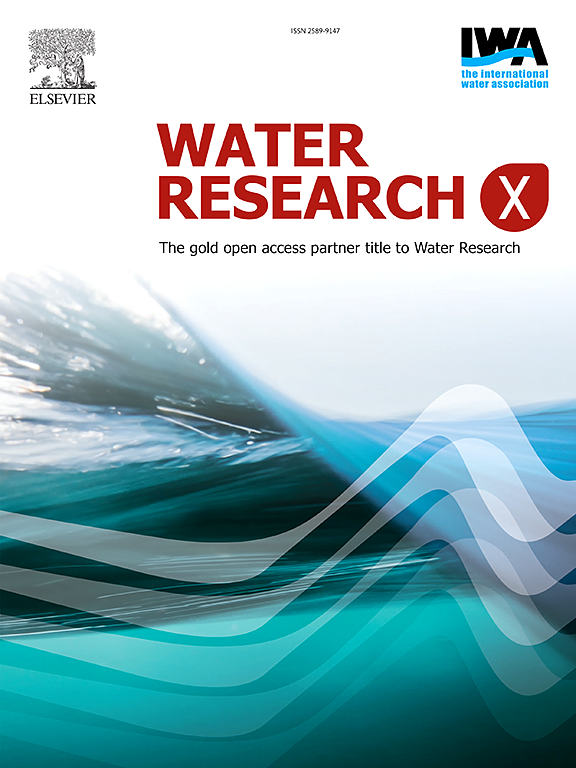浮游植物诱导的硝化抑制限制了浅层富营养化湖泊中硝酸盐扩散对沉积物氮的去除
IF 8.2
2区 环境科学与生态学
Q1 ENGINEERING, ENVIRONMENTAL
引用次数: 0
摘要
广泛分布的浅湖/池塘接收大量人为活性氮(N)输入,成为全球水生生态系统的脆弱组成部分。然而,在这些系统中控制氮保留的机制仍然没有得到充分的探索。我们结合15N示踪标记技术和分子分析来量化中国南方一个热带浅湖(<;1 m深度)的N转化网络,包括水柱中铵态氮(NH4+)吸收、再矿化、硝态氮(NO3−)吸收和硝化作用与沉积N去除能力。高分辨率日报社监测(在36小时内每2小时)显示,日报社中NH4+的显著波动是由白天浮游植物的吸收(高达8.5 μ M h- 1)和颗粒有机氮(PN)的NH4+再生(高达12.3 μ M h- 1)驱动的。相比之下,NO3−保持稳定,浮游植物的吸收或通过硝化作用产生的NO3−可以忽略不计。NH4+和PN之间的相互转移形成了一个闭合的N环。尽管夜间NH4+可用性充足,但硝化作用几乎不存在,这可以通过低氮化物基因丰度(amo A = 0拷贝/mL, amo B≤8 × 103拷贝/mL)来证明,这表明浮游植物的竞争性排斥。这种抑制硝化作用限制了沉积物的NO3−供应,并可能限制了反硝化作用,特别是由上覆水扩散所贡献的反硝化作用,尽管测量的反硝化速率表明在NO3−升高的条件下具有很强的潜力。本研究阐明了富营养化光照良好的浅层生态系统中氮循环和生态位竞争在驱动氮保持和自净化能力中的关键作用。本文章由计算机程序翻译,如有差异,请以英文原文为准。

Phytoplankton-induced nitrification suppression limits sediment nitrogen removal via nitrate diffusion in shallow illuminated eutrophic lake
Widespread shallow lakes/ponds receive substantial anthropogenic reactive nitrogen (N) inputs to be vulnerable components of global aquatic ecosystems. However, the mechanisms governing N retention in these systems remain inadequately explored. We combined 15N tracer-labeling techniques and molecular analysis to quantify N transformation networks, including ammonium (NH4+) uptake, remineralization, nitrate (NO3−) uptake and nitrification in water column versus sedimentary N removal capacity in a tropical shallow lake (<1 m depth) in southern China. High-resolution diel monitoring (every 2 h over 36 h) revealed pronounced diel fluctuations in NH4+, driven by daytime phytoplankton uptake (up to 8.5 µM h−1) and NH4+ regeneration from particulate organic nitrogen (PN) (up to 12.3 µM h−1) in diel rhythms. In contrast, NO3− remained stable, with negligible uptake by phytoplankton or production via nitrification. The reciprocal transfer between NH4+ and PN formed a closed N cycle loop. Nitrification was nearly absent despite ample NH4+ availability at night, as evidenced by low nitrifier gene abundances (amo A = 0 copies/mL, amo B ≤ 8 × 103 copies/mL), suggesting competitive exclusion by phytoplankton. This suppression of nitrification restricted NO3− supply to sediments and likely limited denitrification particularly contributed from the overlying water diffusion, though measured denitrification rates indicated strong potential under elevated NO3− conditions. This study elucidated the pivotal role of diel N cycling and ecological niche competition in driving N retention and self-purification capacity in eutrophic well-lit shallow systems.
求助全文
通过发布文献求助,成功后即可免费获取论文全文。
去求助
来源期刊

Water Research X
Environmental Science-Water Science and Technology
CiteScore
12.30
自引率
1.30%
发文量
19
期刊介绍:
Water Research X is a sister journal of Water Research, which follows a Gold Open Access model. It focuses on publishing concise, letter-style research papers, visionary perspectives and editorials, as well as mini-reviews on emerging topics. The Journal invites contributions from researchers worldwide on various aspects of the science and technology related to the human impact on the water cycle, water quality, and its global management.
 求助内容:
求助内容: 应助结果提醒方式:
应助结果提醒方式:


